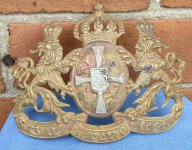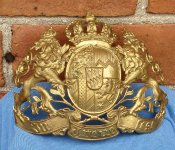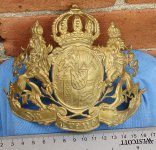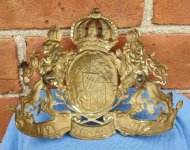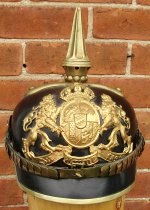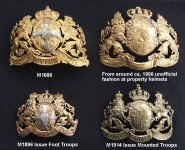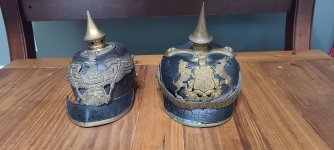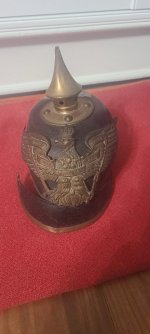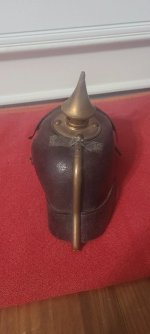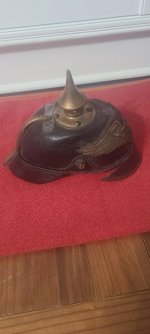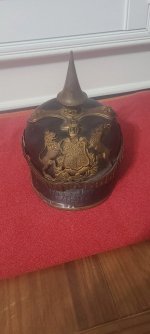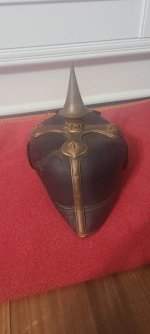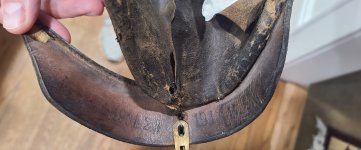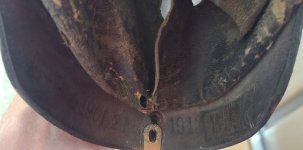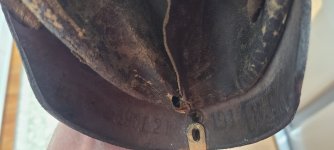Continuing on with this theme of educating/helping new collectors, let's take a brief look at some officer wappen:
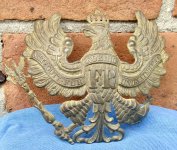
Naturally, we begin with the Prussians as they had the most Regiments in the Imperial Army and it was their king who was Emperor of all the Germans. So, this is the most common Prussian Infantry Officer helmet plate. We still have the Prussian Eagle with initials FR and motto holding an orb and sceptre. The obvious difference here is that the crown is pierced/segmented while the OR's crown is solid. All Prussian officer crowns no matter what branch of service, are pierced in this manner. This also applies to the other kingdoms, principalities and duchies in the rest of the army. The officer wappen being a private purchase item is mercury gilded/frosted and of a finer quality than the OR's. This example needs a good cleaning so it is darker than other officer examples.
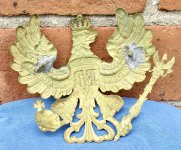
On the reverse, we see the usual "puddles" of solder and T based screw posts. On this piece, the brass square nuts and tin washers are missing but normally that is how the wappen is held on to the shell.
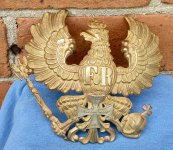
Our next example shows a Prussian Reserve officer wappen. The reservist cross of contrasting white metal is located on the tail feathers and has the Prussian motto. Consequently, the eagle has no bandeau/ribbon unlike our first plate. If this were a Landwehr officer wappen, the cross would be larger and fixed to the chest of the bird. The 1815 date celebrates Prussia's defeat of Napoleon.
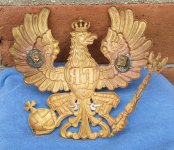
This piece has it's original brass square nuts and tin washers. You can also see the bent prongs holding the cross on. Sometimes, there are drops of solder on these to really secure them to the wappen. Again, we can see the crown piercing.
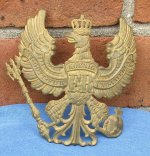
Our next example comes from an Prussian Jaeger officer shako. The bird is much smaller and its wings are more vertical to fit on the front of this type of headdress. Once again, beautiful details and mercury gilding. Note also, the overlapping chest feather where they meet at the eagle tail. This is a characteristic of Prussian shako and Ulan wappen.
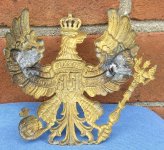
The reverse holds a bit of a surprise, as we see brass prongs instead of screw posts. More experienced collectors have told me that these indicate a "wartime" manufactured wappen. I have found this on Bavarian officer pieces as well and I guess the savings comes with the fact that no screw posts or nuts have to be used??
When speaking of "wartime production" the collector may find zinc/pot metal versions of all the fittings on an officer helmet. Specifically.....chin scales, rear spine, visor trim, spike, wappen and split prong brads. All of these originally had some kind of "gold/brass wash" on them to look like pre war quality. We also find a mixture of brass and zinc parts on these officer helmets and these are totally original and legit!. Last, a Prussian pioneer officer plate from a helmet that I own.
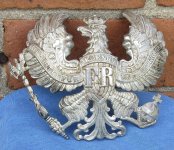
Pierced crown as usual. Now, I mentioned that tunic buttons always matched the fittings on the helmet. This holds true before 1910 but after this year the Imperial Army adopted the feldgrau uniform so the helmet fittings remained the same but they no longer matched the buttons on the 1910 tunic.
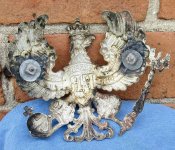

Naturally, we begin with the Prussians as they had the most Regiments in the Imperial Army and it was their king who was Emperor of all the Germans. So, this is the most common Prussian Infantry Officer helmet plate. We still have the Prussian Eagle with initials FR and motto holding an orb and sceptre. The obvious difference here is that the crown is pierced/segmented while the OR's crown is solid. All Prussian officer crowns no matter what branch of service, are pierced in this manner. This also applies to the other kingdoms, principalities and duchies in the rest of the army. The officer wappen being a private purchase item is mercury gilded/frosted and of a finer quality than the OR's. This example needs a good cleaning so it is darker than other officer examples.

On the reverse, we see the usual "puddles" of solder and T based screw posts. On this piece, the brass square nuts and tin washers are missing but normally that is how the wappen is held on to the shell.

Our next example shows a Prussian Reserve officer wappen. The reservist cross of contrasting white metal is located on the tail feathers and has the Prussian motto. Consequently, the eagle has no bandeau/ribbon unlike our first plate. If this were a Landwehr officer wappen, the cross would be larger and fixed to the chest of the bird. The 1815 date celebrates Prussia's defeat of Napoleon.

This piece has it's original brass square nuts and tin washers. You can also see the bent prongs holding the cross on. Sometimes, there are drops of solder on these to really secure them to the wappen. Again, we can see the crown piercing.

Our next example comes from an Prussian Jaeger officer shako. The bird is much smaller and its wings are more vertical to fit on the front of this type of headdress. Once again, beautiful details and mercury gilding. Note also, the overlapping chest feather where they meet at the eagle tail. This is a characteristic of Prussian shako and Ulan wappen.

The reverse holds a bit of a surprise, as we see brass prongs instead of screw posts. More experienced collectors have told me that these indicate a "wartime" manufactured wappen. I have found this on Bavarian officer pieces as well and I guess the savings comes with the fact that no screw posts or nuts have to be used??
When speaking of "wartime production" the collector may find zinc/pot metal versions of all the fittings on an officer helmet. Specifically.....chin scales, rear spine, visor trim, spike, wappen and split prong brads. All of these originally had some kind of "gold/brass wash" on them to look like pre war quality. We also find a mixture of brass and zinc parts on these officer helmets and these are totally original and legit!. Last, a Prussian pioneer officer plate from a helmet that I own.

Pierced crown as usual. Now, I mentioned that tunic buttons always matched the fittings on the helmet. This holds true before 1910 but after this year the Imperial Army adopted the feldgrau uniform so the helmet fittings remained the same but they no longer matched the buttons on the 1910 tunic.

Last edited:

